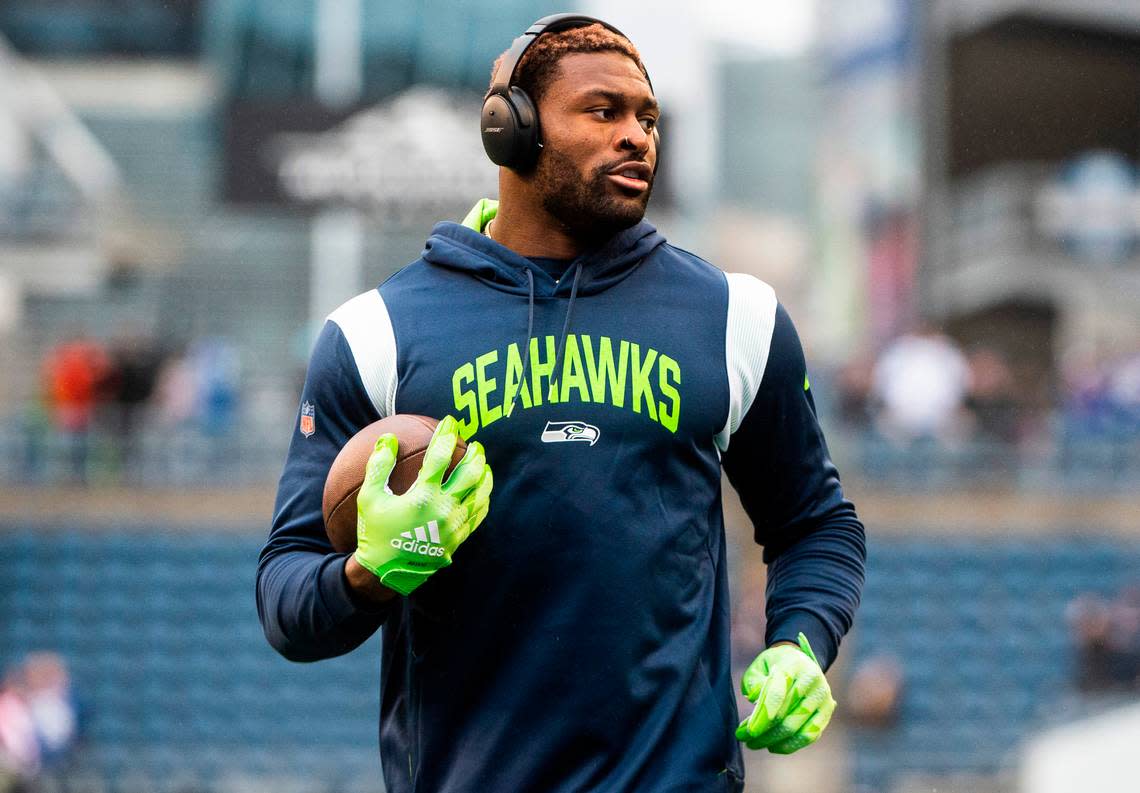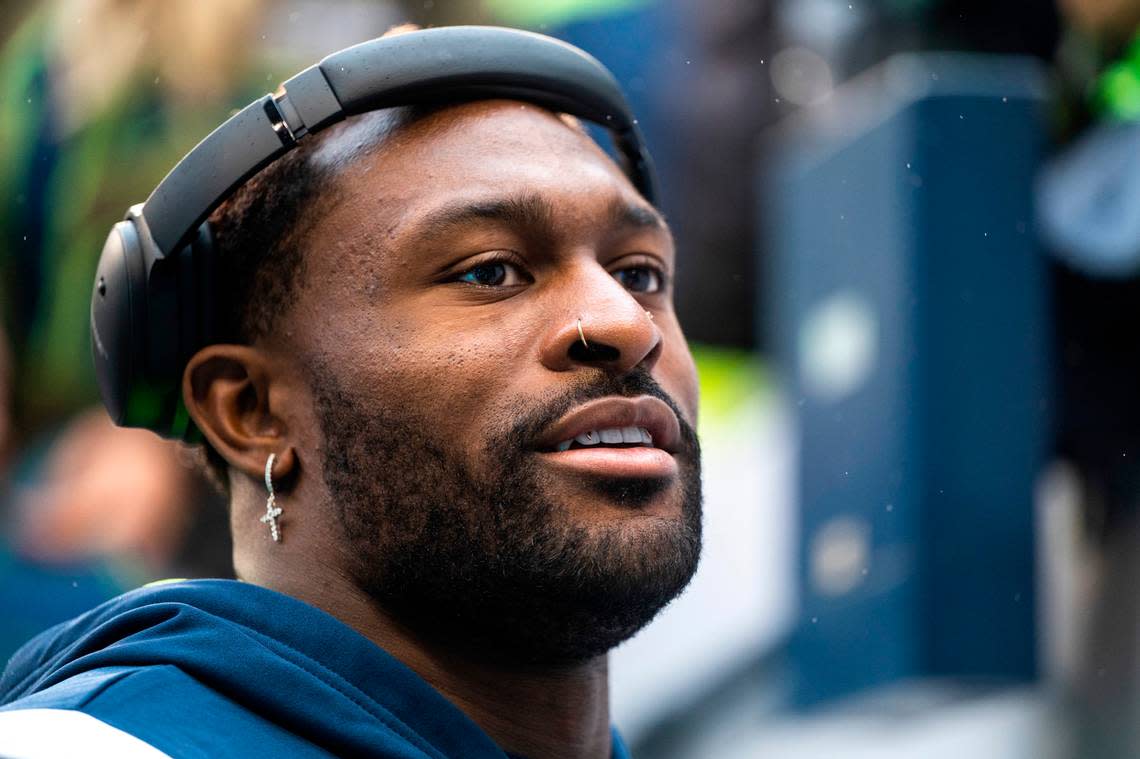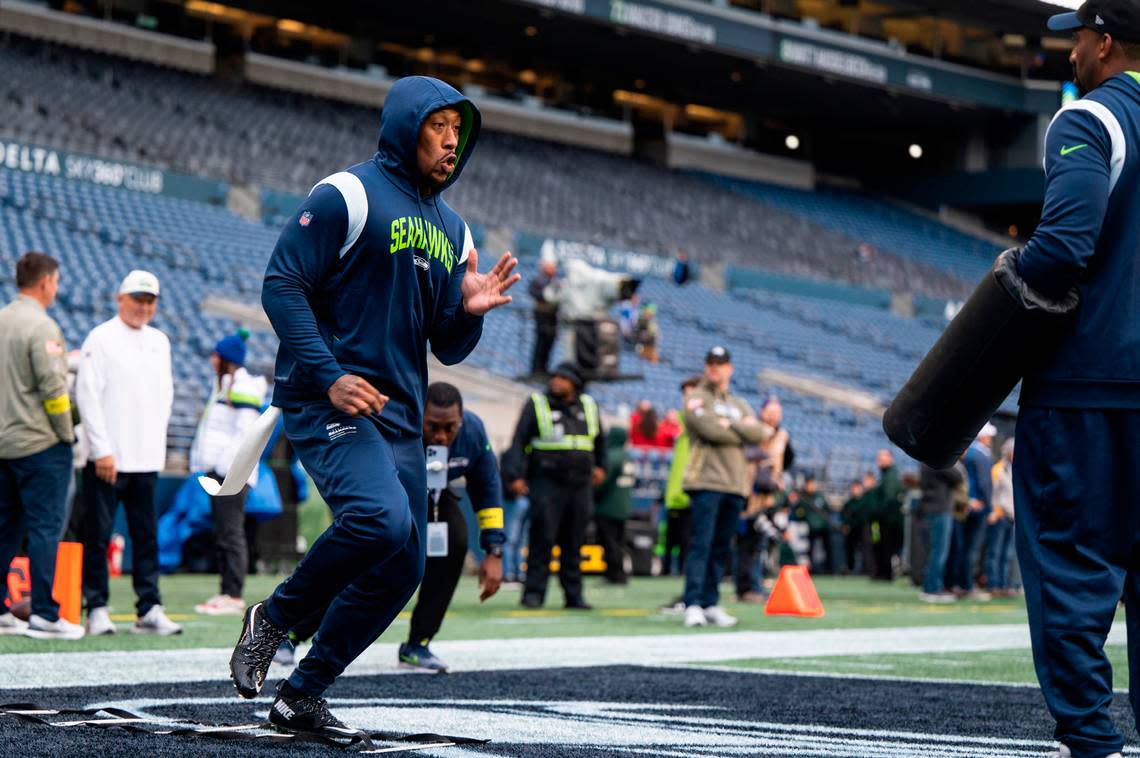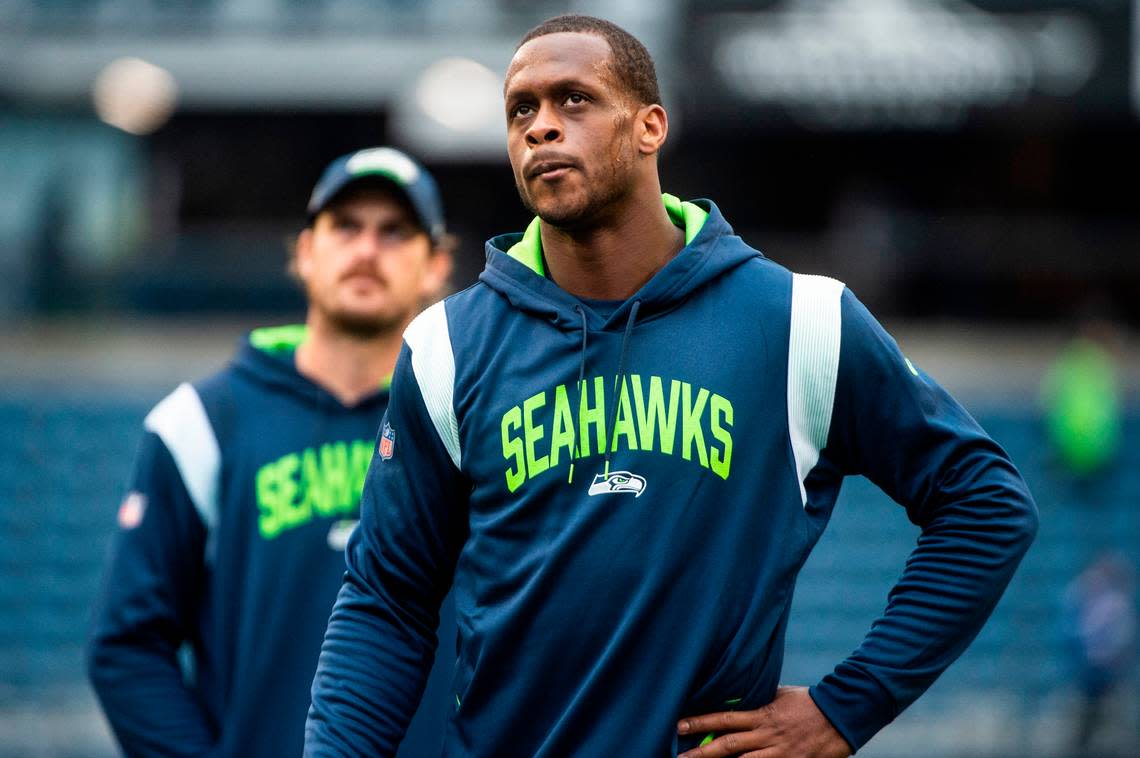Seahawks have a Plan 1A with DK Metcalf, Tyler Lockett hurting: using 3 tight ends
The Seahawks made a move before their test against the New York Giants to deal with DK Metcalf’s knee injury.
They promoted Cade Johnson from the practice squad Saturday to have another wide receiver.
Metcalf, Seattle’s $70 million star, didn’t practice all week on his injured knee yet was active for Sunday’s game. He jogged routes lightly during early warmups and caught passes from quarterback Geno Smith. There was no brace or wrap visible over his knee under his cropped uniform pants.
DK Metcalf jogging lightly, catching passes from Geno Smith in early Seahawks pregame trying to play vs the Giants 7 days after injuring his patellar tendon. @thenewstribune pic.twitter.com/FA0Zjig36f
— Gregg Bell (@gbellseattle) October 30, 2022
Tyler Lockett was also active and playing against the Giants. The captain had a sore hamstring from the previous week, then felt pain in his oblique-muscle and rib areas Thursday.
The Seahawks had listed Metcalf and Lockett as questionable to play Sunday.
“David Stricklin, our trainer, said it best: ‘He’s just built different,’” general manager John Schneider said Sunday on the Seahawks’ radio network’s pregame show.
“He totally is.”
Offensive coordinator and play caller Shane Waldron has a more impacting way to offset any limitations of Metcalf and Lockett than calling up Johnson from the practice squad.
It’s one he’s been using more often and more effectively this season.
Actually, it’s three. As in, three-tight end formations.
As Greg Cosell, senior producer and analyst with NFL Films, said to The News Tribune on Sports Radio 93.3 KJR radio Friday, no team in the league has used multiple tight ends more through seven games of this season than the Seahawks. And they don’t use just two.
They acquired Noah Fant from Denver in the Russell Wilson trade. They re-signed Will Dissly for $24 million over the next three years. And Colby Parkinson is as healthy as he’s been since the team drafted him in 2020.
Last season, when Gerald Everett and Dissly were Seattle’s top tight ends and Parkinson played less than a fourth of the offensive snaps, the Seahawks used two-tight end formations 26% of the time. Waldron used three tight ends on just 4% of plays in 2021.
But this season Waldron has used all three in “13 personnel” groupings, one running back with three tight ends, more than ever. Waldron has used them in the run game, the pass game, the motion game — a lot of each game.
He figured to use them more Sunday in the expected wind and rain at Lumen Field against the rugged, 6-1 Giants.
“The job we have as an offensive staff is trying to fit it to our players and the players that we have on our current roster,” Waldron said before the Seahawks hosted the Giants. “With the flexibility of the tight ends and the receiving group being able to mix in and out, and we have done that with the running backs, as well...a lot of the guys that are maybe the second- or third-team guy having the ability to go right in the game and have meaningful reps throughout the game.”
Dissly played 54 and Fant 52 of Seattle’s 71 offensive snaps Oct. 23 at the Los Angeles Chargers, the day Metcalf injured the patellar tendon in his left knee in the first half. Parkinson played 27 snaps. That meant each of the three tight ends played at least 38% of offensive downs in a 37-23 win, the Seahawks’ most impressive of the season entering Sunday.
“Now, obviously, we have some studs in Colby and Noah,” Dissly, a former University of Washington defensive lineman, deadpanned, “so it just really works.”
Tight ends lead Kenneth Walker
Waldron and the offense have had particular success this season using motion with their multiple tight ends. That has set them up for optimal blocking angles on defenders, usually on the edge, for some of Seattle’s biggest running plays this season.
On rookie Kenneth Walker’s 74-yard toss sweep right for a touchdown that sealed the Seahawks’ win at the Chargers, Waldron sent Parkinson in motion from left to right across the formation. As Walker was receiving the pitch from quarterback Geno Smith, Dissly deftly got across the face of Chargers outside linebacker Kyle Van Noy to seal the right edge. Then Dissly crunched Van Noy to the turf with his block outside right.
Walker cut inside that, and another pivotal block by Parkinson on the second level. The former Stanford stand-up tight end more a wide receiver pushed Chargers defensive back Asante Samuel Jr. into the Seahawks sideline. Walker then had no one in front of him on his 74-yard sprint to the game-clinching touchdown in the fourth quarter.
“That was fun. It’s just nice to get the edge,” Dissly said. “I think, as a tight end, that’s kind of on you. You’re the point of attack and if it doesn’t go well, then it’s on you.
“To have it get the edge and go for a touchdown was really satisfying, but I wasn’t alone on that block. Colby obviously did a hell of a job and you saw the offensive lineman reach on the linebackers, so it wasn’t just me at that point. But it was really nice to get the edge for sure.”
Parkinson’s blocking has been progressing over the last year, since Waldron arrived in 2021 from the Rams’ tight-ends heavy schemes as L.A.’s former tights-ends coach. Parkinson said his block on Walker’s touchdown at the Chargers was the best one of his career.
“Yeah, what was it, a 74-yard touchdown run?” the 6-foot-7 Parkinson said. “Tough to beat that.
“It’s really fun when we get the motion and out onto guys.”
Waldron has multiple intents with the pre-snap motion. The first is the most common: to see how the defense reacts to it. If it has a cover man mirror the motion man across the formation, the defense is likely playing man-to-man coverage at the snap. That gives the quarterback and offensive linemen a read on what Seattle’s progressions in receiver routes, pass protection and run-blocking will be for that play.
The other reason to specifically motion the tight ends: to set up better angles to block, with a running start.
“I think that is the whole reason to move guys, is to get an advantage,” Dissly said. “It’s not a foreign thing. A lot of teams do it, to recognize coverage or see which way they are setting their passing strength, or if it is a run, setting fronts or getting linebackers to move back and forth. It’s always to an advantage.
“I think that is the beauty of being in Shane’s system in year two, we now have a better understanding of why we are doing motions. So as a year-two guy in this offense, it helps a lot.”
Seahawks inactives
The inactive Seahawks for Sunday’s game: injured reserve wide receiver Penny Hart, moth-balled cornerback Sidney Jones, defensive back Teez Tabor, special-teams captain Nick Bellore (concussion), offensive lineman Jake Curhan, defensive tackle Myles Adams and running back Tony Jones.
Gabe Jackson was active and started at right guard. He had missed the previous two games with a knee injury.
Darrell Taylor missed practice time this past week with a groin injury, yet was active to pass rush against New York quarterback Daniel Jones Sunday.




